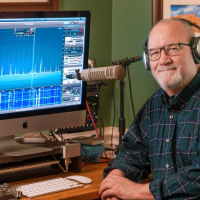SmartSDR v4.1.3 | SmartSDR v4.1.3 Release Notes
SmartSDR v3.10.15 | SmartSDR v3.10.15 Release Notes
The latest 4O3A Genius Product Software and Firmware
Need technical support from FlexRadio? It's as simple as Creating a HelpDesk ticket.
FLDIGI setup on a mac

Answers
-
hi Keith
I have 6600m and i have multiple mac minis
The way you have it setup now, is the same setup i use...
The turn on/off time to send the ptt is almost instant with this setup
i also use loopback and xdax/xcat
since i have M model, i dont not have use dpsdr for all mac setup
and
i also use mldx from Don Agro for all my logging
i have tried flrig with radio set to TS2000
but
found the turn on/off for ptt was in the order of 2 to 3 seconds...
NOT the best solution ;-(
Paul K3SF
0 -
Thanks, Paul, I using the Hamlib connection to the radio seems to make the transition from transmit mode to listen mode very quickly. But I need to set up al the macros before I make some contacts. Had everything working on windows, but having fun getting it all working on the mac now.0
-
Kieth,
Couldn't find your call to email you so decided to respond here. I am in the middle of getting a Mac Mini setup and am at the Flidigi stage. Any info you can offer would be appreciate, links, etc.
Warren KC0GU
0 -
I had it working at one point and made a few RTTY contacts. Did not find it decoded CW as well as I had hoped. Been about a year since I have tried, but will fire it up this weekend and report back with my setup. My email is keithm@mac.com
My FT8 setup is very robust and have fun with it. If you did not run across it, the video of that setup is at:
https://vimeo.com/436933157/8192c3955f
Keith
WA5VTT
0 -
Hi Keith, this is from another FLEX group that I did the other Day and maybe it will help you a little
DAX: you can use either the built in DAX or XDAX stand alone BUT ONLY one of them, but the built in one is very limited to just a couple of slices.
XDAX and XCAT: make sure you select the Radio in the Radio chooser in each of the X Programs.
Then in loopback make sure you have the XDAX sound devices set up for each XDAX device that XDAX created including the DAX TX (like you have in the Windows DAX Program)
In XCAT build a 127.0.0.1:5011 device or similar.
For FLDIGI use the Kenwood TS2000 radio profile NOT the Flexradio profile and HamLib, the FlexRadio radio profile crashed here every time I went into transmit mode and be sure to set up the COM settings in FLDigi for the 127.0.0.1:5011 IP CAT port that you previously created in XDAX.
Thanks to the guys on here who have given me a few ideas on the Email Reflector and the above is what worked for me.
hope this helps get you going, I was VERY frustrated over a year with setting up the MAC stuff and so glad I got it working.
0 -
wow, there are too many terms in there I do not know. I need screen shots of the setup. I am receiving but have not rig control for frequency or ptt. where is that discussion you mentioned?
Keith
WA5VTT
0 -
Hi Keith
Okay here goes some screen grabs of my configuration
Here is the XCAT Radio Chooser, When you select up your Radio and click on in the "Set as Default" and "Connect" will not be grayed out and you can select what you want, Where i have two radio's I want to do this manually. ONCE you select on "Set as Default" you won't see the Radio chooser anymore.
Here is my CAT ports I added for 4 Slices A,B,C,D (Change the CAT Port to something NOT previously used on your Network) using the Edit command on the first one then when you create the others they will follow in sequence.
Here is how I configured Loop Back at the Bottom Left you will see "New Virtual Device" I added one of these for Each slice and 1 for DAX TX. You do not really need a Monitor device unless you want to listen to your Audio.
XDAX This is how I set my XDAX us
Here is the Radio chooser, sets it up the SAME as the XCAT chooser, ONCE you select on "Set as Default" you won't see the Radio chooser anymore.
How I set up my XDAX Audio ports, When you start SmartSDR be sure to click on the buttons in front of the "TX Stream", "RX Stream's" and "Mic Stream" you use.
You will notice I set my XDAX and XCAT up similar to the Windows DAX and CAT so I don't get confused.
BE SURE you have DAX clicked in SmartSDR, just like you do in Windows.
There are a lot of ways to set this up but this is how I do it here and seems to work to my liking.
hope this helps
1 -
Thanks, visuals help! Some day someone needs to post a acronym summary:
xDAX stand for? and it function is?
xCAT
DIGU
SLICE
UDP broadcast?
DXLab TCP
...
I think I now have FLDIGI working in tandem with MacloggerDX and FLDIGI on a Mac and will post a video soon. Would love someone who understand the lingo to tell me if I have something that is not optimal.
0 -
Okay Warrant, hope this helps: (corrections and better ways to proceed welcome. )
------------
This link will take you to a rather long video showing the setup I have for the following combination:
FLDIGI, Mac, DogparkSDR, MacloggerDX, Xcat,Xdax, DogparkSDR and of course a Flexradio. I am new at this so corrections or advice on a better way to proceed are welcome.
1 -
Keith Most of the acronyms are in the Flex SmartSDR user guide.
xDAX stand for? and it function is?: It stands for Digital Audio Cross connect, it is to handle the Audio in and out of the SDR Radio and 3rd party soundcard type programs The X just separates the MAC and Windows versions
xCAT : It stands for Computer Aided Transceiver and it is used to handle the Serial or IP communication in and out of a Radio and 3rd party programs, The X just separates the MAC and Windows versions
DIGU : This stands for a mode on the Radio like USB, LSB, FM or AM and is used for Digital communication like WSJT-X, FLDigi, RTTY etc. using the USB mode, DIGL uses LSB they turn off ALL Transmit processing regular USB and LSB has on so you get the cleanest Data signal as possible.
SLICE: basically separate Receivers / Panadapters on the FLEX radios that the Primary or multiple users can use to operate the Radio either remotely or locally, The 6300 and 6400 have 2 Slices, 6600 and 6500 have 4 Slices and the 6700 has 8 Slices.
UDP broadcast? This is a type of protocol that JUST sends data without listening for a response to make sure the Data packet gets through like TCP does and does NOT send the Packet over again, It is NOT a good way to send Data over the Internet or your local network, it is used by some NON critical uses on the internet and your local network.
DXLab TCP: (Two different things) DXLab is a multifunction Logging type 3rd party program.
TCP: in the form of "DXLAB" and other programs have to interface a 3rd party software like DXLab, FLDigi , WSJT-X etc. CAT information WITHOUT converting it to a COM port and back and MANY MANY other uses to control and communicate to other equipment. Using the Local area network the CAT information usually on the IP address of "127.0.0.1" and a port number like ":5001" if your on the same Computer with the programs.
A different port number? looking at it like the post office, the IP address is the Zip code between one computer or device and another and the port is the P.O. Box or street address you want the data to go to.
You can google some of this stuff to get a better information but there you go in a nut shell.
0 -
Very helpful. I have indeed been scouring the Flex manual and doing some Google searches. Regarding DAX. In the case of a Flex, the audio in the computer generated FLDIGI needs to get to the Flexradio which is on the other end of an ethernet cable. So is it correct to say the xDax software "digitizes" that audio and sends over the ethernet to the Flex radio as data? or maybe it is only sending it to SmartSDR (in my case DogparkSDR) which handles putting in on the ethernet.
In any case, I have it working. Just made a 20 minute QSO with a 84 yr old in south Texas and didn't miss a letter. But it is nice to understand how it all works ;-) thanks for the help. I am only 5 min from Flexradio headquarters in Austin, will have to go visit someday with any remaining questions ;-) 3rd party software has to be a challenge for them.
0
Leave a Comment
Categories
- All Categories
- 377 Community Topics
- 2.1K New Ideas
- 630 The Flea Market
- 8.2K Software
- 107 SmartSDR+
- 6.4K SmartSDR for Windows
- 183 SmartSDR for Maestro and M models
- 427 SmartSDR for Mac
- 271 SmartSDR for iOS
- 256 SmartSDR CAT
- 190 DAX
- 382 SmartSDR API
- 9.3K Radios and Accessories
- 36 Aurora
- 251 FLEX-8000 Signature Series
- 7.2K FLEX-6000 Signature Series
- 942 Maestro
- 55 FlexControl
- 865 FLEX Series (Legacy) Radios
- 919 Genius Products
- 461 Power Genius XL Amplifier
- 335 Tuner Genius XL
- 123 Antenna Genius
- 296 Shack Infrastructure
- 208 Networking
- 454 Remote Operation (SmartLink)
- 144 Contesting
- 784 Peripherals & Station Integration
- 139 Amateur Radio Interests
- 1K Third-Party Software







